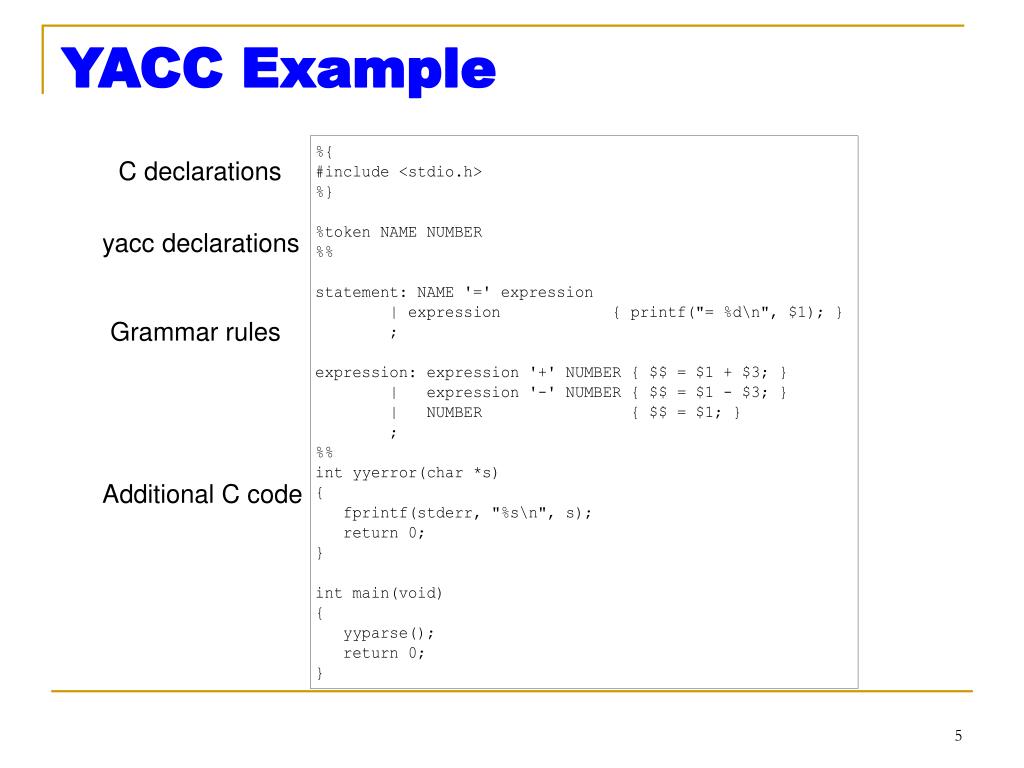Open Command prompt and switch to your working directory where you have stored your lex file (“.l “) and yacc file (“.y “) Let your lex and yacc files be “ hello.l ” and “ hello.y “. Now, follow the preceding steps to compile and run your program. For Compiling Lex file only: flex hello.l; gcc lex.yy.c; For Compiling Lex & Yacc. When LEX and YACC work together lexical analyzer using yylex produce pairs consisting of a token and its associated attribute value. If a token such as DIGIT is returned, the token value associated with a token is communicated to the parser through a YACC defined variable yylval. Then Lex compiler runs the lex.1 program and produces a C program lex.yy.c. Finally C compiler runs the lex.yy.c program and produces an object program a.out. A.out is lexical analyzer that transforms an input stream into a sequence of tokens. I'm having Lex and YACC files to parse my files (.l file and.y file).
Lex & Yaccfor Compiler Writing
Some of the most time consuming and tedious parts of writinga compiler involve the lexical scanning and syntax analysis. Luckily there isfreely available software to assist in these functions. While they will not doeverything for you, they will enable faster implementation of the basicfunctions. Lex and Yacc arethe most commonly used packages with Lex managing thetoken recognition and Yacc handling the syntax. Theywork well together, but conceivably can be used individually as well.
Online Lex And Yacc Compiler C
Then Lex compiler runs the lex.1 program and produces a C program lex.yy.c. Finally C compiler runs the lex.yy.c program and produces an object program a.out. A.out is lexical analyzer that transforms an input stream into a sequence of tokens. I'm having Lex and YACC files to parse my files (.l file and.y file). Open a prompt, cd to the directory where your '.l' and '.y' are, and compile them with: flex hello.l; bison -dy hello.y; gcc lex.yy.c y.tab.c -o hello.exe; You will be able to run the program. I made the sources for a simple test (the infamous Hello World): Hello.l.

Both operate in a similar manner in which instructions fortoken recognition or grammar are written in a special file format. The textfiles are then read by lex and/or yaccto produce c code. This resulting source code is compiled to make the finalapplication. In practice the lexical instruction file has a“.l” suffix and the grammar file has a “.y” suffix. This process is shown inFigure 1.
Figure 1.
The file format for a lex fileconsists of (4) basic sections
- The first is an area for c code that will be place verbatim at the beginning of the generated source code. Typically is will be used for things like #include, #defines, and variable declarations.
- The next section is for definitions of token types to be recognized. These are not mandatory, but in general makes the next section easier to read and shorter.
- The third section set the pattern for each token that is to be recognized, and can also include c code to be called when that token is identified
- The last section is for more c code (generally subroutines) that will be appended to the end of the generated c code. This would typically include a main function if lex is to be used by itself.
- The format is applied as follows (the use and placement of the % symbols are necessary):
%{
//header c code
%}
Online Lex And Yacc Compiler C++
//definitions
%%
//rules
%%
//subroutines
The format for a yacc file issimilar, but includes a few extras.
- The first area (preceded by a %token) is a list of terminal symbols. You do not need to list single character ASCII symbols, but anything else including multiple ASCII symbols need to be in this list (i.e. “”).
- The next is an area for c code that will be place verbatim at the beginning of the generated source code. Typically is will be used for things like #include, #defines, and variable declarations.
- The next section is for definitions- none of the following examples utilize this area
- The fourth section set the pattern for each token that is to be recognized, and can also include c code to be called when that token is identified
- The last section is for more c code (generally subroutines) that will be appended to the end of the generated c code. This would typically include a main function if lex is to be used by itself.
- The format is applied as follows (the use and placement of the % symbols are necessary):
%tokens RESERVED, WORDS, GO,HERE
%{
//header c code
%}
//definitions
%%
//rules
%%
//subroutines
These formats and general usage will be covered in greaterdetail in the following (4) sections. In general it is best not to modify theresulting c code as it is overwritten each time lexor yacc is run. Most desired functionality can be handledwithin the lexical and grammar files, but there are some things that aredifficult to achieve that may require editing of the c file.
As a side note, the functionality of these programs has beenduplicated by the GNU open source projects Flex and Bison. These can be usedinterchangeably with Lex and Yaccfor everything this document will cover and most other uses as well.
Here are some good references for further study:
The Lex & Yaccpage – has great links to references for lex,
Nice tutorial for use of lex &yacc together

http://epaperpress.com/lexandyacc